Chapter 16
Recording Your Hits with GarageBand
In This Chapter
![]() Navigating the GarageBand window
Navigating the GarageBand window
![]() Adding tracks and loops to your song
Adding tracks and loops to your song
![]() Repeating loops and extending your song
Repeating loops and extending your song
![]() Building arrangements
Building arrangements
![]() Adding effects to instruments
Adding effects to instruments
![]() Exporting your work across the globe
Exporting your work across the globe
![]() Burning your song to an audio CD
Burning your song to an audio CD
Do you dream of making music? I’ve always wanted to join a band, but I never devoted the time nor learned to play the guitar. You know the drill: Those rock stars struggled for years to gain the upper hand over an instrument, practicing for untold hours, memorizing chords, and… . Wait a second. I almost forgot. You don’t need to do any of that now!
Apple’s GarageBand lets a musical wanna-be (like yours truly) make music with an iMac — complete with a driving bass line, funky horns, and perfect drums that never miss a beat. In fact, the thousands of prerecorded loops on tap in this awesome application allow you to design your music to match that melody running through your head, from techno to jazz to alternative rock.
This chapter explains everything you need to know to create your first song. I also show you how to import your hit recording into iTunes so that you can listen to it on your iPod with a big silly grin on your face (as I do) or add it to your next iMovie project or iPhoto slideshow.
Shaking Hands with Your Band
As you can see in Figure 16-1, the GarageBand window isn’t complex at all, and that’s good design. In this section, I list the most important controls so that you know your Play button from your Loop Browser button.
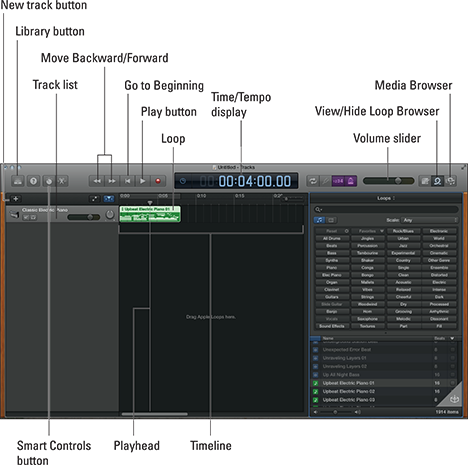
Figure 16-1: The GarageBand window, edged in wood grain, no less.
Your music-making machine includes
- Track list: In GarageBand, a track is a discrete instrument that you set up to play one part of your song. For example, a classical piece for string quartet would have four tracks — one each for violin, viola, cello, and bass. The Track list contains all the tracks in your song arranged so that you can easily see and modify them, like the rows in a spreadsheet. A track begins in the list, stretching out to the right all the way to the end of the song. As you can see in the upper left of Figure 16-1, I already have one track defined — a Classic Electric Piano.
- Timeline: This scrolling area holds the loops (see the following bullet) that you add, compose, or record, allowing you to move and edit them easily. When a song plays, the Timeline scrolls to give you a visual look at your music. (Bear with me; you’ll understand that cryptic statement in a page or two.)
- Loop: Loops — prerecorded clips of an instrument being played in a specific style and tempo — are the building blocks of your song. Most are five seconds in length, and others are even shorter. You can drag loops from the Loop Browser to a track and literally build a bass line or a guitar solo. (It’s a little like adding video clips in iMovie to build a film.) Loops can also be repeated within a track, which I’ll discuss further in a page or two.
- Playhead: This vertical line is a moving indicator that shows you the current position in your song while it scrolls by in the Timeline. You can drag the playhead to a new location at any time. The playhead also acts like the insertion cursor in a word processing application: If you insert a section of a song or a loop from the Clipboard, it appears at the current location of the playhead. (More on copying and inserting loops later, so don’t panic.)
- New Track button: Click this button to add a new track to your song.
- View/Hide Loop Browser button: Click the button with the loop icon to display the Loop Browser at the right side of the window; click it again to close it. You can see more of your tracks’ contents at a time without scrolling by closing the Loop Browser.
- View/Hide Media Browser button: Click this button (which bears icons of a filmstrip, camera, and musical note) to display the Media Browser at the right side of the window; click it again to close it (and see more of your tracks). Use the Media Browser to add media (in this case, digital song files or movies) to your GarageBand project for use as ringtones.
- Go to Beginning button: Clicking this button immediately moves the playhead back to the beginning of the Timeline. (Note this button appears only when you’re not playing a song.)
- Move Back/Forward One Measure buttons: To move quickly through your song by jumping to the previous or next measure, click the corresponding button.
- Play button: Hey, old friend! At last, a control that you’ve probably used countless times before — and it works just like the same control within iTunes or on your audio CD player. Click Play, and GarageBand begins playing your entire song. Notice that the Play button turns green. To pause the music, click Play again; the button loses that sexy green sheen, and the playhead stops immediately.
- Time/Tempo display: This cool-looking LCD display shows you the current playhead position in seconds.
 You can click the clock icon at the left of the display to choose Beats & Project mode, which includes
You can click the clock icon at the left of the display to choose Beats & Project mode, which includes- Measures: Display the current measure and mark the beat
- Chord: Display note and chord names
- Project: Show or change the key, tempo, and signature for the song
- Volume slider: Here’s another familiar face. Just drag the slider to raise or lower the volume.
Of course, more controls are scattered around the GarageBand window, but these are the main controls used to compose a song … which is the next stop!
Composing Made Easy
In this section, I cover the basics of composition in GarageBand, working from the very beginning. Follow along with this running example:
- Click the GarageBand icon in the Dock — it looks like an electric guitar.
- If GarageBand opens a window for a previous project, close it by clicking the Close button in each window.
GarageBand displays the top-level New Project dialog, as shown in Figure 16-2.
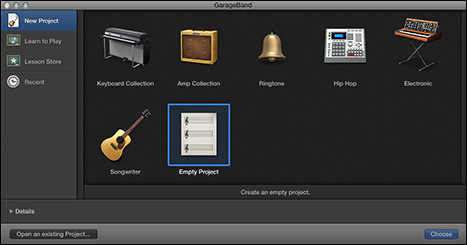
Figure 16-2: Start creating your new song here.
- Click New Project from the list at the left.
- Click the Empty Project icon and click the Choose button.
GarageBand displays the Source dialog.
- Click the Software Instrument icon.
In this chapter, I focus on using software instrument tracks, which are the easiest for a nonmusician to use.
- Click the Create button.
You see the window shown in Figure 16-1. Now you’re ready to add tracks.
Adding tracks
Although I’m not a musician, I am a music lover, and I know that many classical composers approached a new work in the same way you approach a new song in GarageBand: by envisioning the instruments that they wanted to hear. (I imagine Mozart and Beethoven would’ve been thrilled to use GarageBand, but I think they did a decent job with pen and paper, too.)
- A Musical Typing keyboard in your GarageBand window: You can record the contents of a software instrument track by playing the Musical Typing keyboard layout. (As you might imagine, this isn’t the best solution.) If you’re a musician, the best method of recording your own notes is with a MIDI instrument, which I discuss later in the chapter. You can display the Musical Typing keyboard window at any time by pressing
 +K. If the Musical Typing keyboard window is on the screen and you don’t need it, banish the window by pressing
+K. If the Musical Typing keyboard window is on the screen and you don’t need it, banish the window by pressing  +K, or by clicking the Close button in the keyboard window.
+K, or by clicking the Close button in the keyboard window. - The example song with only one empty track: If you want to write the next classical masterpiece for Classic Electric Piano, that’s fine. (I’m a big fan of this instrument, so I use this track later in the example.) Note that you can always delete a track completely, however — click the offending track to select it and then choose Track⇒Delete Track from the GarageBand menu bar.
These are the five kinds of tracks you can use in GarageBand:
- Software instrument tracks: These tracks aren’t audio recordings. Rather, they’re mathematically precise algorithms that your Mac renders (builds) to fit your needs. If you have a MIDI instrument connected to your Mac, you can create your own software instrument tracks. (More on MIDI instruments later in this chapter.)
- Real instrument tracks: These tracks are actual audio recordings, such as your voice or a physical instrument without a MIDI connection. (Think microphone.)
- Electric Guitar and Bass tracks: GarageBand includes a real instrument track especially made for either an electric guitar or bass, which allows you to use a number of different amplifiers and stompboxes (those effect pedals that electric guitarists are always poking with their foot to change the sound of their instruments).
- Drum track: I call this feature “Ringo in a Box” — a drum track that’s automatic, yet very configurable and easy to customize. There are presets galore, so you can quickly jump into different drum sets and playing styles!
- Video tracks: The video sound track appears if you’re scoring (adding music) to an iMovie movie. Along with the video sound track, you get a cool companion video track that shows the clips in your movie. (More on this in the “Look, I’m John Williams!” sidebar, later in this chapter.)
Time to add a software instrument track of your very own. Follow these steps:
- Press
 +Option+N (or click the New Track button).
+Option+N (or click the New Track button).
GarageBand displays the New Track sheet.
- Click the Software Instrument icon and then click Create.
- From the Library pane on the far left, choose the general instrument category you want.
I chose Guitar, which prompts a second list of choices to the right, still in the Library pane.
- From the second list, choose your specific style of weapon, such as Classic Clean for a simple playing style.
Figure 16-3 illustrates the new track that appears in your list when you follow these steps. Now you’re ready to rock with both the original electric piano and an electric guitar! If you like, you can hide the Library by clicking the Show/Hide Library button at the upper-left corner of the window.
 GarageBand includes a Songwriter project (also available from the top-level New Project dialog; refer to Figure 16-2). When you choose a Songwriter project, GarageBand presents you with a full set of instrument tracks, plus a real instrument track for your voice. You’re instantly ready to start adding loops and recording your own voice!
GarageBand includes a Songwriter project (also available from the top-level New Project dialog; refer to Figure 16-2). When you choose a Songwriter project, GarageBand presents you with a full set of instrument tracks, plus a real instrument track for your voice. You’re instantly ready to start adding loops and recording your own voice!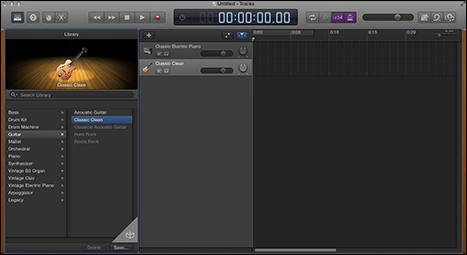
Figure 16-3: The new track appears, ready to rock.
Choosing loops
After you have a new, empty track, you can add loops to build your song from the Loop Browser. Apple provides you with thousands of loops to choose from, in a mind-boggling variety. Click the Loop Browser button (which bears the loop symbol, somewhat like a roller coaster; refer to Figure 16-1) to display your collection, as shown in Figure 16-4.
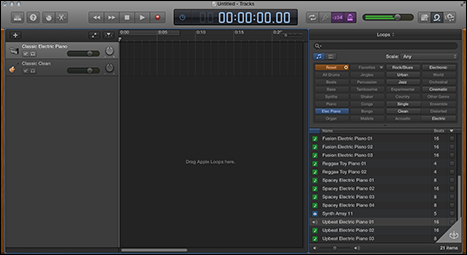
Figure 16-4: The Loop Browser is a great hangout for any musician.
Looking for just the right loop
The running project already includes two tracks but no loops yet. (Refer to Figure 16-3.) Just for grins, add a Classic Electric Piano loop. Follow these steps to search through your loop library for just the right rhythm:
- In the Loop Browser, click the button that corresponds to the instrument you’re using.
I chose the Elec Piano button.
A list of different beats appears in the pane at the bottom of the Loop Browser window. (Check out Figure 16-4 for a sneak peek.)
- Click one of the loops with a green musical-note icon.
Go ahead; this is where things get fun! GarageBand begins playing the loop nonstop, allowing you to get a feel for how that particular loop sounds.
 The examples I chose for this chapter are software instruments, which are identified by a green musical-note icon. (If you’ve got a band at home, have at it with live instruments.)
The examples I chose for this chapter are software instruments, which are identified by a green musical-note icon. (If you’ve got a band at home, have at it with live instruments.) - Click another entry in the list, and the application switches immediately to that loop.
Now you’re beginning to understand why GarageBand is so cool for both musicians and the note-impaired. It’s like having your own band, with members who never get tired, never miss a beat, and play whatever you want while you’re composing. (Mozart would’ve loved this.)
 If you want to search for a particular instrument, click in the Search box at the top of the Loop Browser and type the text you want to match. GarageBand returns the search results in the list.
If you want to search for a particular instrument, click in the Search box at the top of the Loop Browser and type the text you want to match. GarageBand returns the search results in the list. - Scroll down the list and continue to sample the different loops until you find one that fits like a glove.
For this reporter, it’s Upbeat Electric Piano 01; see Figure 16-4.
- Drag the entry to your Classic Electric Piano track and drop it at the very beginning of the Timeline (as indicated by the playhead).
Your window will look like Figure 16-5.

Figure 16-5: A track with a loop added.
Second verse, same as the first
When you compose, you can add tracks for each instrument that you want in your song:
- Each track can have more than one loop.
- Loops don’t have to start at the beginning; you can drop a loop anywhere in the Timeline.
For example, you might prefer to start a song with just your drum kit, with your bass line beginning some time later (for a funkier opening).
Resizing, repeating, and moving loops
If you haven’t already tried listening to your entire song, try it now. You can click Play at any time without wreaking havoc on your carefully created tracks. Sounds pretty good, doesn’t it?
But wait: I bet the song stopped after about five seconds, right? (You can watch the passing seconds using either the Time/Tempo display or the second rule that appears at the very top of the Timeline.) I’m sure that you want your song to last more than five seconds! After the playhead moves past the end of the last loop, your song is over. Click Play again to pause the playback; then click the Go to Beginning button (labeled in Figure 16-1) to move the playhead back to the beginning of the song.
The music stops so soon because your loops are only so long. As I mention earlier, most loops are five seconds in length, and others are even shorter. To keep the groove going, you have to do one of three things:
- Resize the loop. Hover your cursor over either the left or right edge of most loops, and an interesting thing happens: Your cursor changes to icon representing the left or right edge of the loop with an arrow pointing away from the loop. That’s your cue to click and drag — and as you drag, some loops expand to fill the space you’re making, repeating the beats in perfect time. By resizing a loop, you can literally drag the loop’s edge as long as you like.
- Repeat the loop. Depending on the loop that you chose, you might find that resizing it doesn’t repeat the measure. Instead, the new part of the loop is simply dead air. In fact, the length of many loops is limited to anywhere from one to five seconds. However, if you move your cursor over the corner of a loop that you want to extend, it turns into a vertical line with a circular arrow, which tells you that you can click and repeat the loop. GarageBand actually adds multiple copies of the same loop automatically, for as far as you drag the loop. In Figure 16-6, you can see how I repeated the Upbeat Electric Piano 01 loop.
- Add a new loop. You can switch to a different loop to change the flow of the music. Naturally, the instrument stays the same, but there’s no reason you can’t use a horn-riff loop in your violin track (as long as it sounds good played by a violin)! To GarageBand, a software instrument track is compatible with any software instrument loop that you add from the Loop Browser as long as that loop is marked with your old friend, the green musical note.

Figure 16-6: By repeating a loop, you can keep the notes flowing.
Each track can be adjusted so that you can listen to the interplay between two or more tracks or hear how your song sounds without a specific track:
- Click the tiny speaker button under the track name in the list, and the button turns blue to indicate that the track is muted. To turn off the mute, click the speaker icon again.
- You can change the volume or balance of each individual track by using the mixer that appears next to the track name. This comes in handy if you want an instrument to sound louder or confine that instrument to the left or right speaker.
Using the Arrangement track
GarageBand includes another method you can use to monkey with your music: Use the Arrangement track to define (or mark) specific sections of a song, allowing you to reorganize things by selecting, moving, and copying entire sections. For example, you’re probably familiar with the chorus (or refrain) of a song and how often it appears during the course of the tune. With the Arrangement track, you can reposition the entire chorus within your song, carrying all the loops and settings within the chorus along with it! If you need another chorus, just copy that arrangement.
To use the Arrangement track, display it by choosing Track⇒Show Arrangement Track from the GarageBand menu bar. The Arrangement track then appears as a thin strip at the top of the Track list. Click the Add Marker button (the circular button bearing a plus sign) at the right side of the Arrangement track, and you’ll see a new marker appear (as shown in Figure 16-7). You can drag the right side of the Arrangement marker to the left or right to resize it, or drag it to move it anywhere in the song.
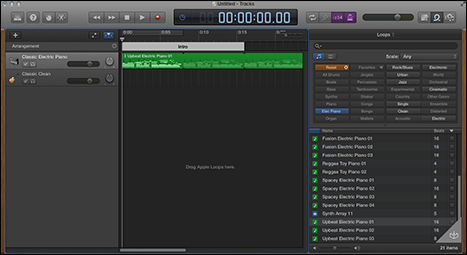
Figure 16-7: I just added a new marker in my song’s Arrangement track.
Now, here’s where Arrangement markers get cool:
- To move an entire Arrangement marker: Click anywhere in the marker’s title bar (except the title itself) and then drag it anywhere you like in the song. (You can hold down Shift while clicking multiple contiguous markers to select more than one.)
- To copy an Arrangement marker: Hold down the Option key and drag the desired marker’s title to the spot where you want the copy to appear.
- To empty the regions in an Arrangement marker: Select it and press Delete. To completely delete the marker, press Delete a second time.
Tweaking the settings for a track
You don’t think that bands like Rush or U2 just “play and walk away,” do you? No, they spend hours after the recording session is over, tweaking their music in the studio and on the mixing board until every note sounds just as it should. You can adjust the settings for a track, too. The tweaks that you can perform include adding effects (pull a Hendrix, and add echo and reverb to your electric guitar track) and kicking in an equalizer (for fine-tuning the sound of your background horns).
To make adjustments to a track, follow these steps:
- Click the desired track in the track list to select it.
- Click the Smart Controls button at the top left of the GarageBand window (labeled in Figure 16-1).
You can also press B to hide or display the Smart Controls pane.
- Click the Controls tab to show the settings shown in Figure 16-8.
- Click the knob control or slider for a specific effect to change the sound.
 GarageBand offers a Visual Equalizer window that you can use to create a custom equalizer setting for each track. From the Smart Controls pane, click the EQ button. To change the Bass, Low Mid, High Mid, or Treble setting for a track, click and drag the equalizer waveform in the desired direction. And yep, you can do this while your song is playing, so you can use both your eyes and ears to define the perfect settings!
GarageBand offers a Visual Equalizer window that you can use to create a custom equalizer setting for each track. From the Smart Controls pane, click the EQ button. To change the Bass, Low Mid, High Mid, or Treble setting for a track, click and drag the equalizer waveform in the desired direction. And yep, you can do this while your song is playing, so you can use both your eyes and ears to define the perfect settings! - Click the Smart Controls button (or press B) to return to GarageBand.
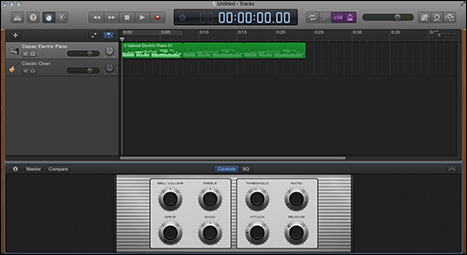
Figure 16-8: Finesse your tune by tweaking the sound of a specific track.
Time for a Mark’s Maxim:
Sharing Your Songs
After you finish your song, you can play it whenever you like through GarageBand. But then again, that isn’t really what you want, is it? You want to share your music with others with an audio CD or download it to your iPod so that you can enjoy it yourself while walking through the mall!
iTunes to the rescue! As with the other iLife applications that I cover in this book, GarageBand can share the music you make through the digital hub that is your Mac.
Creating song files and ringtones in iTunes
You can create an AAC song file (or even a ringtone) from any project in just a few simple steps:
- Open the project that you want to share.
- Choose Share⇒Song to iTunes from the GarageBand menu bar.
GarageBand displays the settings you see in Figure 16-9.
 To create a ringtone and send it to iTunes, choose Share⇒Ringtones to iTunes from the GarageBand menu bar.
To create a ringtone and send it to iTunes, choose Share⇒Ringtones to iTunes from the GarageBand menu bar. - Click in each of the text boxes to type the title, artist name, composer name, album name, and iTunes playlist for the tracks you create.
You can leave the defaults as they are, if you prefer. Each track that you export is named after the song’s name in GarageBand.
- From the Quality pop-up menu, choose the proper audio quality for the finished file.
 The higher the quality, the larger the file.
The higher the quality, the larger the file. - Click the Share button.
After a second or two of hard work, your Mac opens the iTunes window and highlights the new (or existing) playlist that contains your new audio, whether it be a song or a ringtone.

Figure 16-9: Tweaking settings for iTunes audio files.
Exporting a project
Sometimes you’d like to create an audio file from a GarageBand project, but you’d rather not automatically add that song or ringtone to your iTunes Music Library. (Perhaps you now have the audio proof that a family member does indeed snore.) In that case, you can always export a song straight to your hard drive by following these steps:
- Open the project that you want to export.
- Choose Share⇒Export Song to Disk.
- Type a name for the audio file.
Click the button next to the Save As text box to select a specific location where the file should be created, or choose a preset from the Where pop-up menu.
- From the Quality pop-up menu, choose the desired audio quality.
As with sharing a song to iTunes, the higher the quality, the larger the file.
- Click Export.
Burning an audio CD
Ready to create a demo CD with your latest GarageBand creation? If your iMac has an internal or external optical drive, follow these steps to burn an audio disc from within GarageBand:
- Open the song that you want to record to disc.
- Load a blank disc into your optical drive.
If you see a dialog requesting that you choose an action, click the Ignore button.
- Choose Share⇒Burn Song to CD.
Note that the CD you create has only one track. To include more tracks on the CD, share the song to your iTunes Library (as described earlier), create a playlist containing the desired songs, and burn that playlist within iTunes.

 You put loops on separate tracks so that they can play simultaneously on different instruments. If all your loops in a song are added on the same track, you hear only one loop at any one time, and all the loops use the same software instrument. By creating multiple tracks, you give yourself the elbow room to bring in the entire band at the same time. It’s über-convenient to compose your song when you can see each instrument’s loops and where they fall in the song.
You put loops on separate tracks so that they can play simultaneously on different instruments. If all your loops in a song are added on the same track, you hear only one loop at any one time, and all the loops use the same software instrument. By creating multiple tracks, you give yourself the elbow room to bring in the entire band at the same time. It’s über-convenient to compose your song when you can see each instrument’s loops and where they fall in the song. Save your work often in GarageBand, just as you do in the other iLife applications. One power blackout, and you’ll never forgive yourself. When you’re pleased with the progress you’ve made in your project, press
Save your work often in GarageBand, just as you do in the other iLife applications. One power blackout, and you’ll never forgive yourself. When you’re pleased with the progress you’ve made in your project, press